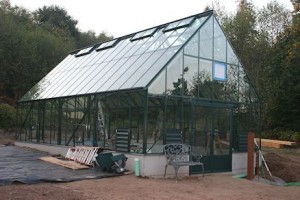The process of procuring and building a greenhouse has given me some very concrete examples of some of the most important elements of a successful project. In part 1, I covered these elements: start with a good plan, build a great foundation, assemble the right team, and solve problems creatively. Here in part 2, I’ll cover three more elements: celebrate successes, set clear and achievable goals, and be realistic with your schedule. Please review part 1 for background info.
Celebrate successes
We found it was not only fun, but critical to take time to celebrate successes in our project. Success for us was the completion of a particularly difficult build step, such as erecting the last truss, or finishing the glazing. As Karen and I (our team of two) were burning ourselves out, the ‘breaks’ not only let us celebrate progress, but also gave us a needed physical break. What did we do for a celebration? We went out to lunch or dinner. There is one excellent local Mexican food restaurant near to our property (Fiesta Jalisco http://fiestainporthadlock.com/). Going there for lunch or dinner is special treat for us. Of course, a good ole-fashioned hug is also a good reward.
Lesson: celebrations are very important activities for most people. They serve as encouragement, recognition, and even rest for a weary team. These are good times to socialize, complain and get sympathy, and even to discuss different ways to tackle the next phase.
Set clear and achievable goals
One of the most difficult parts of any endeavor is developing and communicating a clear vision of where you are going. For our greenhouse, we had access to many photos and drawings that helped us visualize the end product and many of the interim steps. Still, pictures and drawings do not come close to true 3D, physical reality. It is hard to get a sense of size, for example, from a picture. It was tough for us, even when you are told that the shipment for the kit is coming in nine crates, totaling 6,000 lbs, to really grasp how big a bite you just took. When the boxes arrived, we gasped. What did we get ourselves into? But, I’m a firm believer in that old adage:
“How do you eat an elephant? One bite at a time!”
It is easy to get discouraged when you face a seemingly insurmountable goal, but this old adage works. We simply set clear, achievable, short-term goals for ourselves: “Let’s get the north wall sill plate down today. If we have time left, we can start on the south one.” When you string enough of these together, and persevere in the execution, something magical happens: you wake up one day and the entire project is done!
Lesson: Set clear, short-term, achievable goals to reach and even the seemingly impossible is indeed possible!
Be realistic with your schedule
If you don’t do a perfect job of planning (which, by definition, is impossible to do), you will inevitably encounter schedule issues. For our greenhouse build project, we set an overall goal to get Karen’s plants indoors and warm before the first freeze. We knew roughly when this was going to happen in this latitude (November-ish), but, being a famer’s son, you can never count on Mother Nature to cooperate. So, we set a goal of early October, to give ourselves a margin. But, as we had never built a structure like this, with so many parts and dependencies, we had no basis in reality to know if we could achieve this goal. It was just a gut feel. Sometimes, a gut feel is all we have as project managers, even experienced ones. Well, we should have used the old PM trick of tripling the estimate. We practically killed ourselves to complete the project, as one month to build the structure proved insufficient. We had several parts problems, inexperience issues, and other non-project (life) activities that stretched the timeline. In fact, we’ve found that living in the relative ‘country’ compared with our San Jose address, caused everything we did to take longer than we expected. Every time we needed a part at a big box hardware store, for example, we faced a 60 minute round trip for travel alone. Needless to say, we kept meticulous lists.
Lesson: estimate your schedule using all available data, then add an appropriate fudge-factor based on your experience level with the project technology. The less the experience, the greater the cushion should be.
Epilog
 Karen has started to move her most cold-sensitive plants into the new greenhouse, even though we have a few things left to do. She has made excellent progress and we are confident we will achieve our goal. This phase reminds me of all those projects on which I’ve worked where we ‘shipped’ an unfinished product and cleaned up the problems in production. Given the urgency and consequences of failure in our project, I’m very happy with our decision.
Karen has started to move her most cold-sensitive plants into the new greenhouse, even though we have a few things left to do. She has made excellent progress and we are confident we will achieve our goal. This phase reminds me of all those projects on which I’ve worked where we ‘shipped’ an unfinished product and cleaned up the problems in production. Given the urgency and consequences of failure in our project, I’m very happy with our decision.
